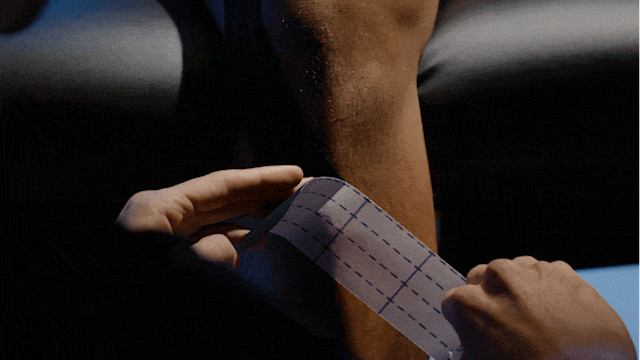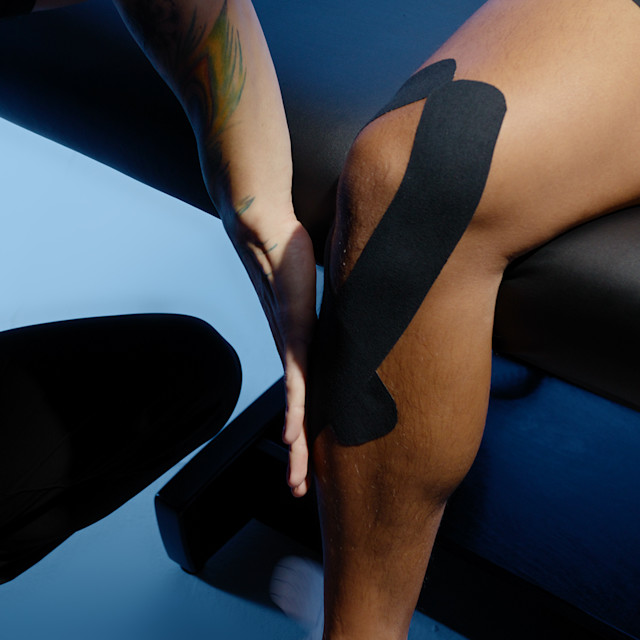Now available as an Equinox Spa treatment, kinesiology taping will support your recovery after a tough workout or injury.
Many of the biohack-y recovery tools that are trendy today have roots in instinctive human behavior. Take cold plunges, for example. Long before ice tubs were all over TikTok, you may have instinctively taken a cold shower after an especially tough workout just because it felt good. Kinesiology tape — a therapeutic adhesive tape now offered as a recovery treatment in Equinox Spas — is another technique that pulls from that same principle: Your body knows what it needs before you’ve even really thought about it.
“Kinesiology tape acts like a ‘big Band-Aid’ in a way,” explains Angel David Rojas, the area Spa manager for Equinox’s Westside NYC Clubs. “When you bang your elbow, your first reaction is to comfort and hold the area.” And that’s basically what kinesiology tape does. Only, unlike taking a couple of seconds to self-soothe, kinesiology tape keeps it up for days, helping you to move through injury and feel better faster and for longer.
Kinesiology Tape, Explained
Kinesiology tape is a simple product: a strip of cotton fabric with an adhesive side and some elasticity to it, explains chiropractor Nick Martichenko, D.C., director of education at Spidertech, the kinesiology tape used in Equinox Spas. It’s been around since the ’70s, when the concept was first created by chiropractor Kenzo Kase, D.C. There are a lot of brands on the market now, though Spidertech was the first to make kinesiology tape cut into specific shapes to fit onto different body parts, like your shoulder, knee, or lower back.
RELATED: Cold Plunges Are the Hot Hotel Amenity

How Kinesiology Tape Works
One of the main purported benefits of kinesiology tape is that it lifts the skin, allowing blood and lymphatic fluid to move more freely throughout the area. Here’s how it works: You stretch kinesiology tape as it goes onto the skin. Its elasticity makes it retract, which elevates the skin, decompresses the tissue, and increases the amount of space for fluid to move, Martichenko explains. This is especially helpful if you have an area that’s swollen or inflamed. “Decompression essentially helps to lift the tissue away from a bony structure, allowing circulation and blood flow to the area. The more blood brought to an area, the quicker the healing process,” Rojas adds.
This lifting also prevents lymphatic fluid from pooling, which can occur due to acute injury or muscle breakdown (such as after a strenuous workout), Martichenko says. When lymphatic fluid pools in an area, the body sends chemicals to over-sensitize the nerves, causing pain. By preventing that pooling with kinesiology taping, you can get pain-relief benefits and also recover faster, he says.
The feeling of the tape on your skin also sends new signals to the nerves in the area, which can offer pain relief, increase muscle activation, and accelerate the body’s natural healing process, Rojas explains. “It's like someone's rubbing the area, which we naturally do when we [hurt ourselves],” Martichenko says. That constant feedback to your brain is a common mechanism for reducing muscle tension and pain. Other recovery modalities, including analgesic creams, acupuncture, or electrical current treatments, do the same thing. “They're all just playing with the mechanical receptors in your skin,” he says. But unlike some of those other therapies, kinesiology tape isn’t a 30-minute treatment; you can wear it all day, every day, for up to a week. “You can bring your therapy with you at all times,” he says.
Though many exercise and medical professionals agree on the above theories, the existing clinical research on kinesiology tape isn’t conclusive. Researchers haven’t been able to pinpoint if or exactly how kinesiology tape offers a benefit. However, there is enough promising evidence to suggest that it’s worth a try. Some studies on breast cancer and knee replacement patients back up the fact that the tape can help reduce fluid build-up, for example, while other studies on shoulder injuries and low-back pain show that people seem to feel better when they have it on, regardless of any measurable physiological effect. That reduction in perceived pain is worth something on its own. Moreover, there’s little to no risk involved (financially or physiologically), making kinesiology tape a valid treatment option even if the main benefit is a placebo.
When to Tape Up
Kinesiology tape works well for muscle or joint soreness and performance-related injuries, especially those that cause swelling or inflammation like muscle sprains and strains, Martichenko says. There are some more novel uses, too, even when you’re not injured; healthcare workers use it under their masks to protect their skin from friction, and you can even place it on your back as a gentle reminder to maintain better posture, he adds.
Unlike traditional athletic tape, which aids via compression and immobilization, kinesiology tape also allows you to keep moving normally and maintain your full range of motion, Martichenko says. This ability to support injured areas while moving is a big reason why you’ll see kinesiology tape on pro athletes, for example, while they’re competing in the upcoming 2024 Olympic Games in Paris.
RELATED: To Steam or to Sauna?
What to Expect at a Kinesiology Taping Session
You can purchase kinesiology tape and DIY — Spidertech’s signature pre-cut shapes make it easier to apply than if you buy a regular roll — but there’s still a learning curve to getting the application right. Getting taped up by a pro the first time (or every time) can ensure you’ll get the most out of the treatment.
During a taping session at Equinox, a licensed massage therapist will perform a consultation to ensure you’re a good candidate for the service, Rojas says. They’ll take you through a series of assessments to see which actions or movements cause pain and which may relieve it. They’ll apply the tape according to your needs, then take you through the series of assessments once again to show the difference in the range of motion and decreased pain and sensitivity, and to ensure it’s applied comfortably to go about your day.
Before the session, don’t apply any lotions or creams to the area you want treated, as it can keep the tape from sticking properly, Rojas says. You can leave the tape on as long as is comfortable, though that’s typically around three to five days.
When it comes time to take it off, you’ll want to use an oil-based moisturizer (such as coconut oil or baby oil) to make removal easier, Rojas says. “The oil will help with dissolving the adhesive used to make it last on the skin.” Pull it off slowly and in the same direction that the hair on the area is growing. If you pull in the opposite direction, it’ll be more painful, almost like getting waxed, he says.
